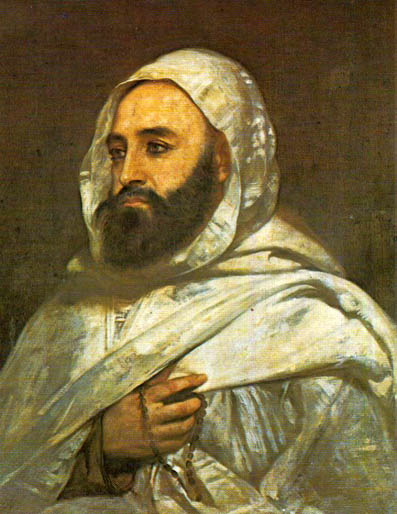Re-Run: Cowboys and Indians, North African Style
Unlikely though it seems, I've spent a lot of time thinking about the French Foreign Legion over the last week.
I bet most of you have a few stock images of the Foreign Legion in your heads: men fleeing from their past into the desert and anonymity, absinthe, burning sands and blazing sun, those funny little billed caps with the flap down the back. (Extra points for anyone who knows what those caps are called.)
For most of us, those images come from trashy novels and B-movies that are kissing cousins to the American western at its least thoughtful. Both genres are heavy on the cavalry*, noble (or savage) armed horsemen as opponents, last chance saloons, and strong, silent heroes. Not to mention burning sands and blazing sun (see above).
And just like in the American western, the dangerous armed horseman on the ridge has his own version of the story.

Abd al-Qadir by Rudolf Ernst
If the French hadn't invaded Algeria in 1830**, Algerian emir Abd al-Qadir would probably have been content to follow his grandfather and father as the spiritual leader of the Qadiriyah Sufi order. In the fall of 1832, when the French began to expand their control into the Algerian interior, the Arab tribes of Oran elected al-Qadir as both the head of the Qadiriyah order and as their military leader.
Al-Qadir led Arab resistance against French expansion in North Africa from 1832 to 1847. He was so successful that at one point two-thirds of Algeria recognized him as its ruler. The French signed treaties with al-Qadir and broke them. (Similarities to the American western, anyone?) After a crushing defeat in 1843, he was hunted across North Africa as an outlaw.
Abd al-Qadir surrendered at the end of 1847 and was imprisoned in France until 1853. Following his release, he settled in Damascus, where he entered the stage of world history one last time. In 1860, the Muslims of Damascus rose and began slaughtering the city's Christians. When the Turkish authorities did nothing to stop the massacre, Abd al-Qadir and 300 followers rescued over 12,0000 Christians from the massacre. Once hunted by the French as a dangerous outlaw, Abd al-Qadir received the Legion of Honor from Napoleon III for his efforts.
Heroism is in the eye of the beholder.
*In fact, the Foreign Legion was an infantry unit. Just saying.
** Over what the French press called the Incident of the Flyswatter. I couldn’t make this stuff up.
Re-Run: Word With A Past–Maffick
The Second Anglo-Boer War (1899-1902) started badly from the British point of view. British troops, supposedly the best trained and best equipped in the world, suffered a series of humiliating defeats at the hands of Boer farmers. (Anyone else hear echoes of another colonial war that pitted farmers against British regulars?)
The only bright spot in the morass of inefficiency and disaster was Colonel Robert Baden-Powell's spirited--and well-publicized--defense of Mafeking, a small town on the border between British and Boer territory. (Yep. The guy who founded the Boy Scouts.)
The siege lasted for 219 days. Undermanned and inadequately armed, Baden-Powell improvised fake defenses, made grenades from tin cans, and organized polo matches and other entertainments to keep the garrison's spirits high. The British public was able to follow "B-P's" defense of Mafeking because the besieged town included journalists from four London papers, who paid African runners to carry their dispatches through the Boer lines.
When news of the garrison's relief reached England, public celebrations were so exuberant that "maffick" became a (sadly underused) verb meaning to celebrate uproariously.
Maffick vt. To celebrate an event uproariously, as the relief of Mafeking was celebrated in London and other British cities.
Personally, I intend to maffick like mad when I turn this book proposal in.
Re-Run: If You Only Read One Book On Islamic History…
Last year I discovered the best general book on Islamic history I've ever read: Destiny Disrupted: A History of the World Through Islamic Eyes by Tanim Ansary. I underlined as I read. I annotated. I put little Post-It tabs at critical points, the durable ones so I could go back to key arguments in the future. In short, I had a conversation with that book.
An Afghani-American who grew up in Afghanistan reading English-language history for fun, Ansary argues that Islamic history is not a sub-set of a shared world history but an alternate world history that runs parallel to world history as taught in the West. In Ansary's account, the two visions of world history begin in the same place: the cradle of civilization nestled between the Tigris and the Euphrates. They end up at the same place: a world in which the West and the Islamic world are major and often opposing players. But the paths they take to the modern world, or more accurately the narratives that explain how "we" got to the modern world, are very different. Ansary's book unfolds those two narratives side by side in clear, lively, and often amusing prose. I found his conclusions compelling.
If you're only going to read one book on Islamic history, do yourself a favor: chose Destiny Disrupted. Then let me know what you think about it.





